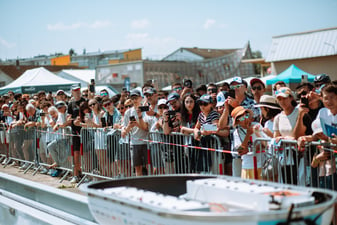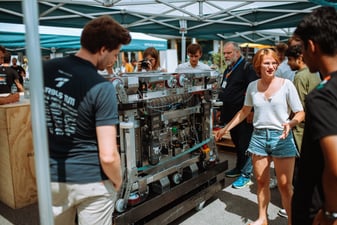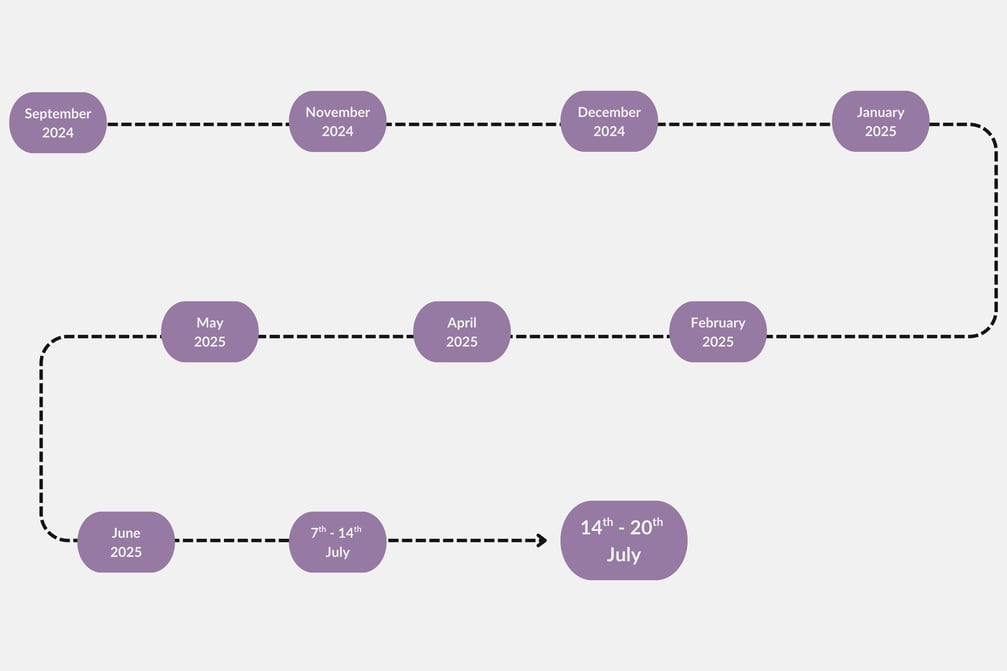


European Hyperloop Week 2025
Competition Overview
Application Categories
Engineering Design and Technology Demonstration
Full-Scale Research
Showcasing
This is the heart of EHW’s technical competition. In this category, teams build and demonstrate functioning Hyperloop systems or subsystems — from levitation and propulsion to guidance, braking, and control. Whether it’s a full integrated pod or a specific test bench, systems are assessed on their design, engineering quality, and real-time performance. Awards are given for outstanding demonstrations in areas like levitation, propulsion, and complete system integration, alongside an overall best-in-show title.
For teams passionate about shaping the future of Hyperloop beyond physical prototypes, this category centers on research projects addressing the challenges of bringing Hyperloop systems to the real world. Teams submit and present papers tackling technical or socio-economic aspects of full-scale Hyperloop implementation — from infrastructure design to public acceptance, safety systems, and sustainability.
Ideal for emerging teams or those focusing on public engagement, this category celebrates the art of communicating Hyperloop technology in clear, creative, and engaging ways. Teams design and present an exhibition stand at EHW, featuring models, interactive displays, posters, and visualizations. The goal is to inspire both technical and general audiences with your vision for Hyperloop’s future.
At European Hyperloop Week (EHW) 2025, we’re bringing together the brightest minds in railway transportation innovation — and offering three exciting ways for teams to take part, contribute, and compete. Here’s what each category involves:







Application Timeline


Registration Opened
Registration Closed
ITD & ITSR Deadline
ITD & ITSR Feedback
SFD Deadline
SFD Feedback & FDD Deadline
Ticketing Opened
Final Deliverables
Preparation Week
European Hyperloop Week
Teams can start to register for all application categories
Registration closed. Additional registrations will be handled case by case depending on logistics limitations
First engineering design and research submission deadline outlining the concept to be presented at the EHW.
Feedback from jury and EHW staff on the submitted documents
Safety Document deadline. This document details the ways the rules and regulations are implemented into the design of the demonstrator.
Feedback on the previous document and Final Design Document deadline. This outlines the key features of the system and working principles.
Ticketing for both the provided EHW accommodation and event tickets opens
FRS Deadline (final research article submission), Video Demonstration (showing the functioning of the demonstration), and showcasing specifics
Track setup and start of scrutineering process for demonstrators
The application process deadlines are outlined below. Exceptions may be granted on a case to case basis (but do not count on it). For more information on the specifics of the deliverables refer to the Rules & Regulations and other templates and technical documents.
Application Timeline
The application process deadlines can be better viewed on the desktop version of the website. Exceptions may be granted on a case to case basis (but do not count on it). For more information on the specifics of the deliverables refer to the Rules & Regulations and other templates and technical documents.

Awarding System
Awards are given within each category, and some awards contribute to an overall score.
Full-Scale Research Awards
Each team can submit a maximum of 2 research articles, each of them has to be targeted at one specific Full-Scale Research Awards, i.e. one for the Technical award, and one for the Socio-Economic award.
Technical Aspects of Hyperloop Systems: This category aims to explore technical aspects of the full-scale Hyperloop system,
including both the pods and the infrastructure
Socio-Economic Aspects of Hyperloop Development: Explore the aspects of Hyperloop development that have to do with the interaction between (the development of) Hyperloop technology and society.
Demonstration Category
Engineering Design Award: Knowledge and engineering quality of the demonstrator. The Final Design Document (FDD) and a Q&A session between the judges and the team will be the main scoring criteria.
Demonstration Awards: Given to teams that excel during the prototype demonstration part of the EHW
Levitation & Guidance: Teams will be judged on whether the systems work (levitation/guidance), stability, energy consumption/efficiency, resistance to disturbances (e.g. external forces, gaps in tracks), Lift-to-Weight, reliability, level of redundancy, ability to reject system faults, and quality of the data, among others.
Propulsion Demonstration: Teams will be judged on whether the system works, stability, energy consumption/efficiency, acceleration, top speed, reliability, level of redundancy, ability to reject system faults, and quality of the data, among others.
Integrated Hyperloop: Teams are judged based on the integration of their demonstrator and their performance. This
includes the demonstration of other essential technologies for the hyperloop such as power transfer, vacuum compatibility, suspension, lane-switching, software, navigation and control, etc
Showcasing Award
Submissions eligible for the Showcasing Award should demonstrate excellence in one or more of the following aspects:
Communication of Technical Concepts:
Clear visualization of complex technical systems
Effective demonstration of engineering principles
Interactive presentations of Hyperloop components
Innovative ways to explain technical challenges
Physical or visual models that enhance understanding
Educational Impact:
Accessibility to different audience levels
Clear presentation of technical information
Engagement with viewers/audience
Quality of visual aids and demonstrations
Effectiveness in explaining complex concepts
Overall Award
Any team participating in the Demonstration Competition will automatically be enrolled and eligible for the Research Submission awards and the Demonstration Category awards and therefore also for the Overall Award. With this award, the EHW wants to highlight the importance of not only the design, manufacturing, and testing of a hyperloop prototype but also the overall awareness of the hyperloop environment and the team’s efforts to contribute to and advance it. Therefore, this award will be given to the best overall team taking into account both the demonstration and research categories.
The points will be distributed as follows:
Awarding System
Awards are given within each category, and some awards contribute to an overall score.
Full-Scale Research Awards
Each team can submit a maximum of 2 research articles, each of them has to be targeted at one specific Full-Scale Research Awards, i.e. one for the Technical award, and one for the Socio-Economic award.
Technical Aspects of Hyperloop Systems: This category aims to explore technical aspects of the full-scale Hyperloop system,
including both the pods and the infrastructure
Socio-Economic Aspects of Hyperloop Development: Explore the aspects of Hyperloop development that have to do with the interaction between (the development of) Hyperloop technology and society.
Demonstration Category
Engineering Design Award: Knowledge and engineering quality of the demonstrator. The Final Design Document (FDD) and a Q&A session between the judges and the team will be the main scoring criteria.
Demonstration Awards: Given to teams that excel during the prototype demonstration part of the EHW
Levitation & Guidance: Teams will be judged on whether the systems work (levitation/guidance), stability, energy consumption/efficiency, resistance to disturbances (e.g. external forces, gaps in tracks), Lift-to-Weight, reliability, level of redundancy, ability to reject system faults, and quality of the data, among others.
Propulsion Demonstration: Teams will be judged on whether the system works, stability, energy consumption/efficiency, acceleration, top speed, reliability, level of redundancy, ability to reject system faults, and quality of the data, among others.
Integrated Hyperloop: Teams are judged based on the integration of their demonstrator and their performance. This
includes the demonstration of other essential technologies for the hyperloop such as power transfer, vacuum compatibility, suspension, lane-switching, software, navigation and control, etc
Showcasing Award
Submissions eligible for the Showcasing Award should demonstrate excellence in one or more of the following aspects:
Communication of Technical Concepts:
Clear visualization of complex technical systems
Effective demonstration of engineering principles
Interactive presentations of Hyperloop components
Innovative ways to explain technical challenges
Physical or visual models that enhance understanding
Educational Impact:
Accessibility to different audience levels
Clear presentation of technical information
Engagement with viewers/audience
Quality of visual aids and demonstrations
Effectiveness in explaining complex concepts
Overall Award
Any team participating in the Demonstration Competition will automatically be enrolled and eligible for the Research Submission awards and the Demonstration Category awards and therefore also for the Overall Award. With this award, the EHW wants to highlight the importance of not only the design, manufacturing, and testing of a hyperloop prototype but also the overall awareness of the hyperloop environment and the team’s efforts to contribute to and advance it. Therefore, this award will be given to the best overall team taking into account both the demonstration and research categories.
The points will be distributed as follows: